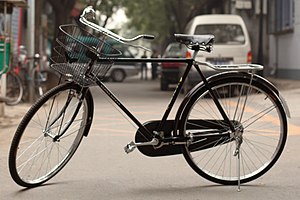| Bicycle | |
|---|---|
 The most popular bicycle model—and most popular vehicle of any kind in the world—is the Chinese Flying Pigeon, with about 500 million produced.[1] | |
| Classification | Vehicle |
| Application | Transportation |
| Fuel source | Human-power (and/or motor-power) |
| Wheels | 2 |
| Components | Frame, wheels, tires, saddle, handlebar, pedals, drivetrain |
| Inventor | Karl von Drais, Kirkpatrick MacMillan |
| Invented | 19th century |
| Types | Utility bicycle, mountain bicycle, racing bicycle, touring bicycle, hybrid bicycle, cruiser bicycle, BMX bike, tandem, low rider, tall bike, fixed gear, folding bicycle, amphibious cycle, cargo bike, recumbent, electric bicycle |
| Part of a series on |
| Sustainable energy |
|---|
 |
A bicycle, also called a pedal cycle, bike, push-bike or cycle, is a human-powered or motor-assisted, pedal-driven, single-track vehicle, with two wheels attached to a frame, one behind the other. A bicycle rider is called a cyclist, or bicyclist.
Bicycles were introduced in the 19th century in Europe. By the early 21st century there were more than 1 billion bicycles.[1][2] There are many more bicycles than cars.[3][4][5] Bicycles are the principal means of transport in many regions. They also provide a popular form of recreation, and have been adapted for use as children's toys. Bicycles are used for fitness, military and police applications, courier services, bicycle racing, and artistic cycling.
The basic shape and configuration of a typical upright or "safety" bicycle, has changed little since the first chain-driven model was developed around 1885.[6][7][8] However, many details have been improved, especially since the advent of modern materials and computer-aided design. These have allowed for a proliferation of specialized designs for many types of cycling. In the 21st century, electric bicycles have become popular.
The bicycle's invention has had an enormous effect on society, both in terms of culture and of advancing modern industrial methods. Several components that played a key role in the development of the automobile were initially invented for use in the bicycle, including ball bearings, pneumatic tires, chain-driven sprockets, and tension-spoked wheels.[9]
- ^ a b Cite error: The named reference
Koeppel2007was invoked but never defined (see the help page). - ^ Cite error: The named reference
Economist2011was invoked but never defined (see the help page). - ^ Cite error: The named reference
Squatriglia2008was invoked but never defined (see the help page). - ^ Cite error: The named reference
AMA2006was invoked but never defined (see the help page). - ^ Cite error: The named reference
ABCwas invoked but never defined (see the help page). - ^ Herlihy 2004, pp. 200–50.
- ^ Herlihy 2004, pp. 266–71.
- ^ Herlihy 2004, p. 280.
- ^ Heitmann, J. A. The Automobile and American Life. McFarland, 2009, ISBN 0-7864-4013-9, pp. 11ff